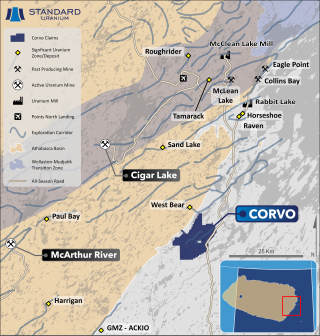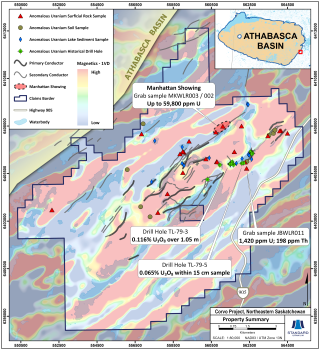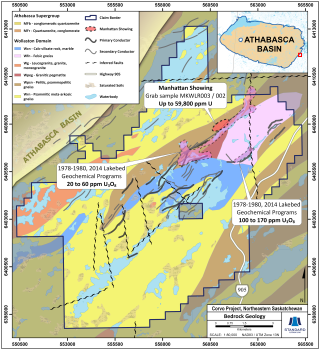Corvo Project
The Corvo project lies beyond the eastern margin of the Athabasca Basin, consisting of 13 mineral dispositions totaling 12,265 hectares (Figure 1). The project was recently expanded to cover 29.3 km of prospective strike length along three northeast trending magnetic low/electromagnetic (EM) conductor corridors. Standard Uranium holds a 100% interest in the property.
Historical airborne and ground electromagnetic work between 1979 and 2017 identified a broad, northeast-southwest trending, conductive system that is approximately 2.5-km wide with prospective targets associated with magnetic-low corridors and cross-cutting faults.
Prospecting, mapping, geochemical surveying, and drilling completed in the late 1970’s and 80’s identified graphitic metasedimentary rocks in outcrop along the conductive corridor and led to the discovery of multiple uraniferous outcrops including SMDI showing 2052 (0.137% U3O8 and 2,300 ppm Th). Lakebed geochemical anomalies returned 10.0 to 16.0 ppm U for Snout Lake and 18.0 to 38.0 ppm U for Hook Lake, both of which are associated with anomalous Ni, Cu, Pb, Co, and Mo. Ten drill holes were completed between 1978 and 1979, all of which were designed to test strong conductors. All drill holes intersected graphitic metasedimentary rocks and further delineated the large EM anomaly. The majority of drilling was attributed to the Snout and Hook Lake area, leaving much of the conductive corridor untested and open for exploration.
Uranium mineralization is present along a strike length of 800 metres in drill holes TL-79-3 (0.116% U3O8 over 1.05 m) to TL-79-5 (0.065% U3O8 over 0.15 m) within the new east-central claim. The expanded claims also add multiple new data points of uranium anomalism to the project, including surface sample JBWLR011, returning 1,420 ppm U.
Historical investigations from 2011 to 2012 identified the Manhattan showing north of Dorward Lake, as well as a uraniferous pegmatite outcrop in the Hook Lake area. Analytical data from the Manhattan showing returned 1.19 to 5.98 wt.% U, as well as elevated Th, Pb, and REEs, while the pegmatite outcrop returned 279 ppm U and elevated REEs (1.29 wt.% total REE).
These significant surficial uranium occurrences on the Corvo Project, coupled with elevated radioactivity in drill core and lakebed geochemical anomalies, support the exploration model for shallow, high-grade, basement-hosted uranium mineralization on the Corvo Project, akin to the recently discovered Gemini Mineralized Zone located 45 km southwest of the property.
Disclosure of Technical and Scientific Information
Except as otherwise noted herein, Sean Hillacre, MSc. P.Geo., Standard Uranium’s VP Exploration, has reviewed and approved the scientific and technical information contained in this website. Mr. Hillacre is a Qualified Person within the meaning of Canadian Securities Administrator’s National Instrument 43-101.



